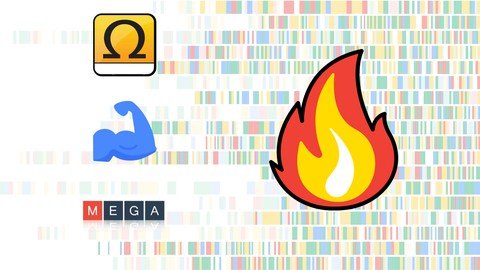
Free Download Sequence Alignment Made Simple For Research - A Quick Guide
Published 11/2023
MP4 | Video: h264, 1920x1080 | Audio: AAC, 44.1 KHz
Language: English | Size: 880.55 MB | Duration: 0h 43m
Learn the best of sequence alignment through hands on practice exercises and best instructions.
What you'll learn
Understand the basics and importance of sequence alignment.
Learn about different types of sequence alignment: global, local, and semiglobal.
Get familiar with sequence alignment terminology such as gap, match, mismatch, and score.
Gain knowledge about different algorithms used for sequence alignment like Needleman-Wunsch and BLAST
Learn to use popular software tools for sequence alignment such as BLAST and CLUSTALW.
Understand the applications of sequence alignment through case studies.
Get hands-on practice with real-world data sets.
Delve into advanced topics in sequence alignment, including multiple sequence alignment, structural alignment, and gene prediction.
Requirements
Basic Knowledge: Learners should have a basic understanding of biology and some computational skills. This will help them grasp the concepts of sequence alignment and its applications more effectively.
Technical Requirements: Access to a computer with an internet connection is necessary to use the software tools for sequence alignment such as BLAST and CLUSTALW.
Time Commitment: Learners should be able to dedicate sufficient time for the course, including time for hands-on practice with real-world data sets.
Curiosity and Interest: An interest in computational biology and a curiosity to understand how sequence alignment contributes to various biological contexts will make the learning process more engaging and enjoyable.
Language Proficiency: Since the course appears to be in English, proficiency in English would be beneficial for understanding the course content.
Description
Embark on a journey into the world of sequence alignment with this comprehensive course. This course is designed to provide a thorough understanding of sequence alignment, its importance, and its various types - global and local. You'll become familiar with key terminology and delve into the intricacies of algorithms used for sequence alignment, such as Needleman Wunsch and BLAST.The course offers several advantages:In-depth Knowledge: Gain an in-depth understanding of sequence alignment, its types, and its significance in biological research.Practical Skills: Learn to use popular software tools like BLAST and CLUSTALW, equipping you with practical skills that are highly valued in the field of bioinformatics.Real-world Applications: Through case studies, explore the various applications of sequence alignment in biological contexts, enhancing your ability to apply theoretical knowledge to real-world scenarios.Hands-on Experience: Get hands-on practice with real-world data sets, providing you with valuable experience that can be applied in your future work or research.Advanced Topics: Delve deeper into advanced topics, including multiple sequence alignment, structural alignment, and gene prediction, expanding your knowledge beyond the basics.The course then takes you further into the fascinating world of sequence alignment. You'll explore advanced topics, including multiple sequence alignment, structural alignment, and gene prediction. These topics will provide you with a deeper understanding of the field and prepare you for more complex challenges in your future work or research.Whether you're a student, a researcher, or a bioinformatics professional, this course offers valuable insights and practical skills. By the end of the course, you'll have a solid foundation in sequence alignment and be ready to apply your knowledge in various biological contexts. Go Ahead and Enroll Now!, to start your journey into the fascinating world of sequence alignment.
Overview
Section 1: Introduction to sequence alignment
Lecture 1 Introduction
Lecture 2 What is sequence alignment and why is it important?
Lecture 3 Overview of different types of sequence alignment
Lecture 4 Basic concepts and terminology
Section 2: Algorithms and software for sequence alignment
Lecture 5 Overview of different algorithms used for sequence alignment
Lecture 6 Needleman-Wunsch Algorithm in Python
Lecture 7 Smith waterman Algorithm in Python
Lecture 8 Introduction to popular software tools for sequence alignment
Lecture 9 Using ClustaW
Lecture 10 Using MUSCLE
Lecture 11 Using T-Coffee
Lecture 12 Using the MAFFT
Section 3: Applications of Sequence Alignment
Lecture 13 Applications of Sequence Alignment
Lecture 14 Identification of Conserved Domains
Lecture 15 Detection of Homologous Sequences
Section 4: Advanced topics in sequence alignment
Lecture 16 Multiple sequence alignment
Lecture 17 Structural alignment
Lecture 18 Gene prediction
Students studying biology, bioinformatics, or a related field who are interested in learning about sequence alignment and its applications.,Researchers in the field of biology or bioinformatics who want to understand the algorithms and software used for sequence alignment.,Bioinformatics professionals who want to enhance their skills and knowledge in sequence alignment.,Individuals interested in computational biology and want to understand how sequence alignment contributes to various biological contexts.,Anyone who wants hands-on practice with real-world data sets in the context of sequence alignment.
Homepage
Recommend Download Link Hight Speed | Please Say Thanks Keep Topic Live
No Password - Links are Interchangeable






